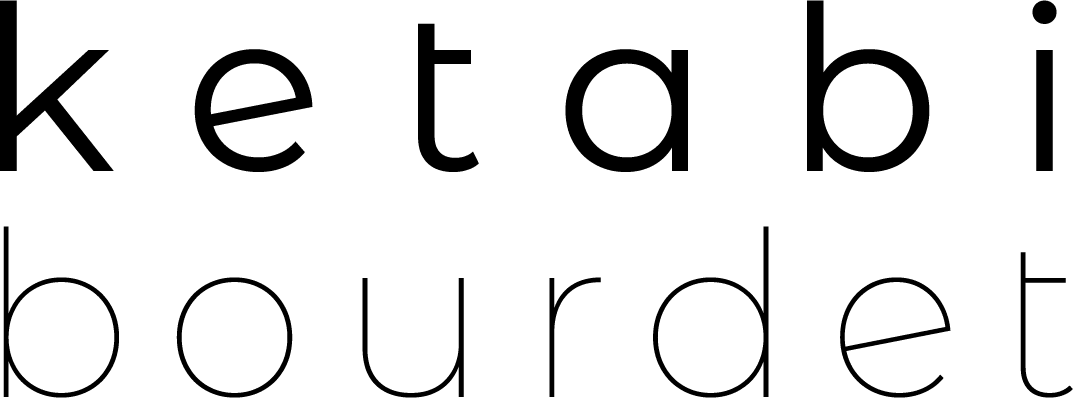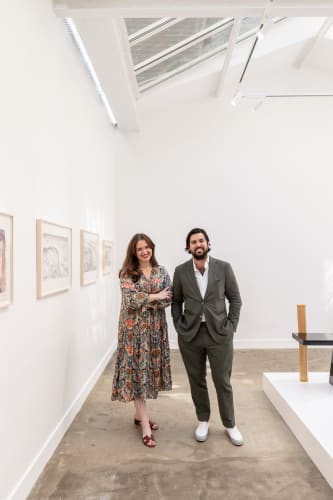In April 2022, the Parisian galleries Ketabi Projects and Paul Bourdet Fine Furniture joined forces to launch Ketabi Bourdet. The merger by friends and co-founders Charlotte Ketabi-Lebard and Paul Bourdet combined each’s areas of focus—contemporary art and a mix of 1980s, 1990s, and contemporary design—to make up two pillars of one space. Today, Ketabi Bourdet is comprised of a main exhibition location at 22 Passage Dauphine, hosting regular presentations of art, design, and more, alongside a showroom at 19 rue Guénégaud (open by appointment only) acting as a multipurpose venue for projects and happenings outside of the main program.
Inès Longevial’s work inaugurated the gallery last spring with “World on Paper.” They’ve since put on Robert Wilson’s “A Chair and its Shadow,” the group show “Glace à L’Italienne,” and Philippe Starck’s “Ubik,” which closed last week. Next month, a selection of art and design in “Premiers vertiges” (“First thrills”) is on view March 11 through April 7, curated by Elise Roche.
WHITEWALL: How did the merger between Ketabi Projects and Paul Bourdet Fine Furniture first come about?
CHARLOTTE KETABI-LEBARD: Paul and I were already very close friends since our studies. We both left our masters programs before actually getting our degrees as we each had a job offer, Paul with Galerie Downtown - François Laffanour and me with Galerie Nathalie Obadia. For five years we traveled together to all the main art fairs and events—Art Basel, Frieze New York, the Venice Biennale, etc. So we basically had the same work experience, each within our own specialty.
PAUL BOURDET: In 2019, I left my home gallery to start Paul Bourdet Fine Furniture, and Charlotte followed in 2020 with Ketabi Projects. We each dabbled our own way but because of the covid crisis, there isn’t much we could do as galleries were closed.
In 2021, when Charlotte started renting nomadic spaces for her shows, she didn’t have an everyday place to go to work so I told her to come and work in my space. After a few months, we realized how much each of us brought the other: another perspective, a different eye on things. We have very different ways of working which are complimentary: while I am more on the creative side, Charlotte is more down to earth and makes the clocks turn on time.
CKL: We also realized that our collectors were the same. So by sharing our expertise, values, experience, and clients, we decided to merge. One year later, we now share everything: Paul isn’t responsible for design and I’m not responsible for art, we both do it all.
WW: What was your focus for programming in the gallery’s first year?
CKL: When you look at this list, one thing definitely pops up: our will to present solo shows of both artists and designers to dive deep into their creation and show the extent of what they do. The artists we show do share something in common—they have a specific connection to color, and all in their own way represent values, ideas, and ways of thinking and creating that are deeply anchored in our era.
What we would like to do is to represent creation throughout the last century, from the 80s to today. We also like to use group shows to mix art and design and show how pieces can dialogue together in a very pertinent manner.
WW: The space focuses on two pillars: contemporary art and design. What does this look like in the context of programming?
CKL: Regarding programming, our aim is to present yearly 6-8 solo exhibitions of contemporary art, two of design, and one or two group shows mixing both. The difference between both is that to prepare a contemporary art show, we only have the gallerist’s work to do—the artist creates the works! For design, we need to hunt down all the pieces which takes lots of time, at least six months.
PB: The link between art and design exists independently of the gallery at all times but the goal is to have a clear program and that neither art nor design [takes away from] each other but rather brings something to it! The idea is more to create a platform for enthusiasts where they can come to see either art or design and sometimes something out of their comfort zone.
WW: Tell us about “Premiers vertiges” (“First thrills”), curated by Elise Roche. How did you come to decide Roche was someone to whom you could give carte blanche of the gallery? Can you tell us about her concept for the show and the significance of its title?
CKL: I started working with Elise many moons ago when I was still director at Nathalie Obadia gallery. More recently, I asked Elise to write a few of our press releases as we trust her instincts with artists, and she has a great eye. When talking with her last year about a text she was writing, I had the idea to offer her to curate a show at the gallery as she would bring a new point of view to our gallery.
The concept for the show “Premiers vertiges,” is to present artists from the emerging scene (painting, video, fashion, design, photography) questioning their world and their identity. creators who, because they do not yet submit to any kind of determination, manage to create a breach in reality to discover and explore new worlds where forms are still in perpetual mutation.
WW: What kind of process went into planning this exhibition with Roche? What kind of dialogue takes place between the different mediums and areas of focus that one doesn’t get from a show centered on just one medium?
CKL: We planned the exhibition together, her, Paul, and I. From the selection of artists to the selection of their works, Elise brought to our attention some artists, we asked for some on our side, and we found a way to make everything work together. The fact that there is different media induces true dynamism and conveys a true artistic scene and idea.
PB: The idea was to create a show in which [all of the] works are interconnected in order to create a very coherent whole. We will, for example, display a work by outsider artist Henry Darger and an important rocking chair by Robert Wilson designed in 2011 for the play Zinnias: The Life of ClementineHunter, which depicts the life of Hunter, another American outsider artist. These links are what make the show interesting and meaningful.
-- Clik on the link below --

